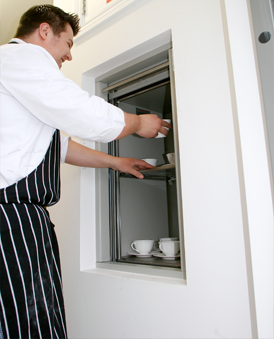Different types of service lifts and their uses
Contents |
Introduction
There are many different types of service lifts, all designed to offer simple, quick and efficient solutions where lifting problems may occur. Service lifts and dumbwaiter lifts are designed for a variety of professional environments, but they are not intended for human use.
This results in service lifts being exempt from many regulations which apply to other lift types. They are also highly flexible, as they tend to occupy less space than other lifts.
Service lifts can offer improvements in productivity, adapting to businesses needs whilst following building regulations.
Dumb waiter lifts
Dumb waiter lifts, also known as micro-lifts, food lifts or kitchen lifts, are used for transporting food or drink between floors. They are most commonly found within restaurants, bars, pubs, or within the homes of individuals with limited mobility. They are sometimes also installed in retail, office and medical environments.
They were first invented in the 19th century, with the original meaning of the phrase indicating a device more akin to a serving tray. Dumb waiter lifts can be adjusted to suit premises which are restricted in terms of headroom and have problematic maintenance access and limited space.
Dumbwaiter lifts can carry an average of 50-100 kg, and can move at 0.35 m/sec to serve up to six separate floors.
Dumb waiter lifts can improve business efficiency by transporting meals, materials, or other objects in less time than would be possible by foot. Additionally, they can reduce the strain on a person’s body or the risk of injury from carrying objects.
Trolley lifts
Trolley lifts are useful in circumstances where larger and heavier loads need to be transported, and can handle loads up to 300 kg. Used in settings such as retail, hotel or commercial premises to transport trolleys and crates, they can serve the same number of floors as dumb waiters, generally up to six floors, but they are slightly slower, with an average speed of 0.17 m/sec.
Operating inside a structure-supported frame, a trolley lift is easy to install and causes little disruption to business, and, with no motor room or ‘load-bearing’ shaft required, they are also cheaper.
Continuing technological innovations result in a typically lower cost, and their quick installation causes minimal disruption.
Find out more
Related articles on Designing Buildings Wiki
- Considerations When Installing a Residential Lift.
- Escalator.
- Lifting device.
- Lifts and Their Special Operating Modes.
- Lifts for buildings.
- Lifts for office buildings.
- The importance of service lifts.
- The science of lifts.
--Nathan Massey 14:22, 16 Oct 2017 (BST)
Featured articles and news
Construction Skills Mission Board launch sector drive
Newly formed government and industry collaboration set strategy for recruiting an additional 100,000 construction workers a year.
New Architects Code comes into effect in September 2025
ARB Architects Code of Conduct and Practice available with ongoing consultation regarding guidance.
Welsh Skills Body (Medr) launches ambitious plan
The new skills body brings together funding and regulation of tertiary education and research for the devolved nation.
Paul Gandy FCIOB announced as next CIOB President
Former Tilbury Douglas CEO takes helm.
UK Infrastructure: A 10 Year Strategy. In brief with reactions
With the National Infrastructure and Service Transformation Authority (NISTA).
Ebenezer Howard: inventor of the garden city. Book review.
The Grenfell Tower fire, eight years on
A time to pause and reflect as Dubai tower block fire reported just before anniversary.
Airtightness Topic Guide BSRIA TG 27/2025
Explaining the basics of airtightness, what it is, why it's important, when it's required and how it's carried out.
Construction contract awards hit lowest point of 2025
Plummeting for second consecutive month, intensifying concerns for housing and infrastructure goals.
Understanding Mental Health in the Built Environment 2025
Examining the state of mental health in construction, shedding light on levels of stress, anxiety and depression.
The benefits of engaging with insulation manufacturers
When considering ground floor constructions.
Lighting Industry endorses Blueprint for Electrification
The Lighting Industry Association fully supports the ECA Blueprint as a timely, urgent call to action.
BSRIA Sentinel Clerk of Works Training Case Study
Strengthening expertise to enhance service delivery with integrated cutting-edge industry knowledge.
Impact report from the Supply Chain Sustainability School
Free sustainability skills, training and support delivered to thousands of UK companies to help cut carbon.
The Building Safety Forum at the Installershow 2025
With speakers confirmed for 24 June as part of Building Safety Week.
The UK’s largest air pollution campaign.
Future Homes Standard, now includes solar, but what else?
Will the new standard, due to in the Autumn, go far enough in terms of performance ?
BSRIA Briefing: Cleaner Air, Better tomorrow
A look back at issues relating to inside and outside air quality, discussed during the BSRIA briefing in 2023.
Restoring Abbotsford's hothouse
Bringing the writer Walter Scott's garden to life.
Reflections on the spending review with CIAT.



























